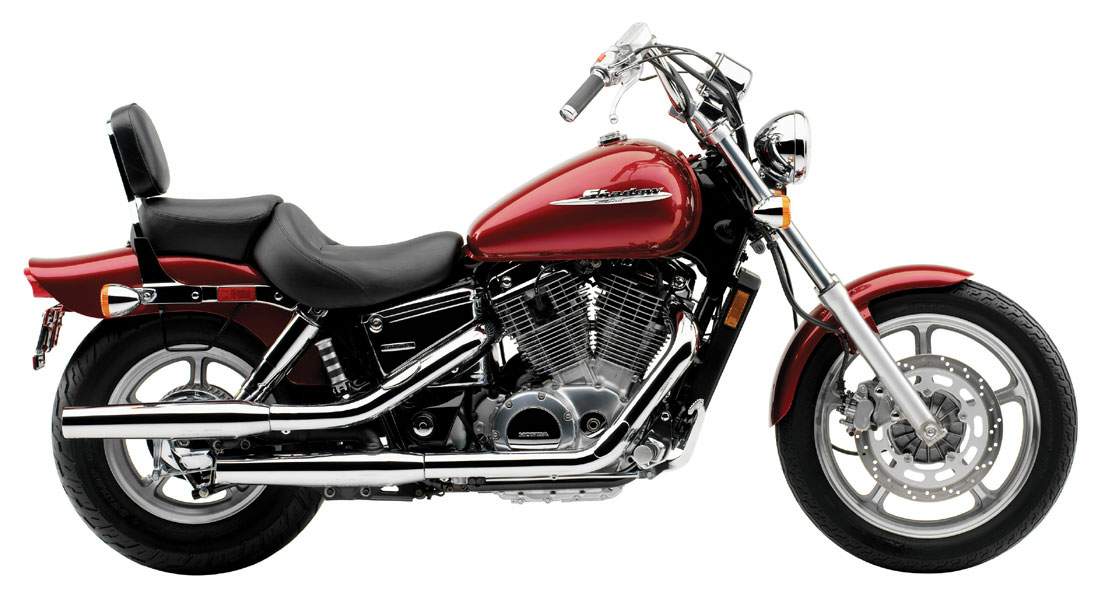
Honda VT 1100C Shadow Spirit SPECIFICATIONS, PRICE & IMAGES
Twin Motorcycles Compared: Yamaha Virago
vs. Honda ACE, Aero and Spirit
mileage: 38.3 mpg; quarter-mile acceleration – 14.92 sec., 86.2 mph.
Spirit: Price – $8599-8899; displacement – 1099cc; wet weight – 592
lb; seat height – 28.5 in.; wheelbase – 65.0 in.; fuel capacity – 4.2 gal.; fuel
mileage:42.5 mpg; quarter-mile acceleration – 13.86 sec., 94.1 mph.
these bikes were generally ranked in alphabetical order: Aero, American Classic, Spirit, Virago. The retro styling of the new Honda,
particularly in the orange/cream paint scheme we rode, received almost universal
approval. The A.C.E. was close. Most people like the Spirit better than the
“1970s post-industrial” look of the Virago. The Special version of the Virago we
tested has more chrome than the standard model; but some of it seems excessive
or, as on the unpolished rear drive housing, wasted. The paint quality got high
marks all around. The Spirit was a 1997-spec machine, which differs graphically
from the ’98 model but is otherwise the same.
There are two areas where there are major differences: looks and performance.
The Virago is significantly faster than the others and, to most eyes, the
homeliest. If the styling doesn’t grate on you and the looks of the Aero or
A.C.E. don’t raise your pulse rate, the Virago’s functional advantage — and
low, low price — make it an easy choice. If styling is a prime consideration,
the Aero or A.C.E. probably top your list. The added flair and power of the Aero
easily justify its price. If you want cleaner styling than the Virago offers,
but still want the smoothness of the offset crankshaft, the Spirit might be your
Shadow — though we’d recommend riding an Aero before you dismiss it as too
buzzy. This class offers no dominant player, just a series of attractive
choices; none of which have any glaring functional flaws. No matter which one
you choose, you’ll find someone on our staff who agrees with your choice.
Jamie Elvidge: If I could morph the Virago’s engine with the Aero’s look and the
A.C.E.’s ergonomics, I might get a perfect 1100 V-twin. The Virago tops my list
in the performance category. It’s quick and easily controlled, even with its
spongy suspension. I like to get some bang for my buck, so the price here is
definitely right too. Yamaha’s time-honored twin could take the whole cake, I
believe, with a trip to the restyle shop. The Aero, although undeniably
attractive with a ready-to-pounce profile, is a little too long and low for my
taste. I felt like I needed glasses to read the speedo and my lower back didn’t
appreciate my hands and feet being anchored so far forward. The A.C.E. gave me
the best fit. It may lack power, but the comfort combined with taut suspension
(something I prefer), bearable vibration, and above-average looks make it my
pick for a long haul.
Evans Brasfield: Leave it to Honda to introduce the Aero and eviscerate the
competition, even if two-thirds of those competitors are also from Honda. The
A.C.E. had the looks department locked up until the Aero appeared with its cool
headlight/instrument cluster, which cleaned up the handlebar lines and set the
tone for the whole long look of the bike. What about the fishtail pipe? In this
case, size definitely matters, and the Aero’s exhaust note clinches the
decision.
his website: Evans Brasfield.
Art Friedman: As Evans requested, I’ll call him shallow. A pretty face has
turned his head. Sure the Aero is a striking companion for a dalliance at the
drive-in; but for a lasting relationship, the comfort, performance, and handling
of the Virago win me over.
Richard Cicchino: You won’t be disappointed if you buy any one of these
motorcycles. Spending two days on the road with these four machines was an
absolute blast.
Kevin Smith: I have two favorites in this group, depending on how we define our
terms. Honda’s lovely new Aero sweeps the beauty pageant, no question. The
period motif is handled deftly, with deeper fenders that still look graceful and
well-balanced. The detailing is clean, and the finish work is impeccable. I
especially like how the motorcycle seems to drop down out of the way of your
view in front. Snuggling the speedo into the headlamp shell feels much less
intrusive than propping it up in my face, as the other Shadows do.

Bike Features
Make Model:
Honda VT 1100C Shadow Spirit
Year:
2002-04
Engine:
Four stroke, 45°V-Twin, OHC, 3 valves
per cylinder.
Capacity:
1099 cc / 67.1 cub in.
Bore x Stroke:
87.5 x 91.4 mm
Compression Ratio:
8.5:1
Cooling System:
Liquid cooled
Oil Capacity:
3.8 L / 4 US
quarts
Induction:
2 x 36 mm Keihin carbs.
Ignition:
Solid-state digital – two spark plugs per cylinder
Starting:
Electric
Max Power :
67 hp / 49 kW @ 5500 rpm
Max Torque:
91 Nm / 9.27
kgf-m / 67 lb-ft. @ 2700 rpm
Transmission:
5 Speed
Final Drive:
Shaft
Front Suspension:
41mm Telescopic forks, 150mm wheel travel
Rear Suspension:
Dual shocks, spring preload adjustable, 100mm wheel
travel
Front Brakes:
Single 316mm disc 2 piston caliper
Rear Brakes:
Drum
Front Tyre:
110/90-19
Rear Tyre:
170/80-15
Seat Height:
730mm / 28.7 in.
Dry Weight :
250 kg / 553 lbs
Fuel Capacity:
15 Litres / 3.9 US gal
